
Welcome to The Matterhorn: intersections of literature & art! I investigate ideas through the arts with a cultural studies lens. The website is under construction for Season 2 - more in a couple weeks!
Thanks for joining me here! I would love to hear your thoughts in the comments.
What do fashion icons mean to the little people, like me?
I remember exactly what I was doing when I learned that Yves Saint Laurent had died. I’ve never owned anything by the designer nor had I been particularly fascinated by him. However, for me, he was an enigmatic symbol of Parisian culture — fashion, freedom, defiance of norms, possibilities. That was all I had at the time of his death.
Since then, I’ve learned a lot, but with only that haziness of his persona, on June 2, 2008 in Paris, I learned of his death while seated solo for lunch on the terrace of Le Relais de l’Entrecôte in Paris 6e district. This restaurant used to be a Parisian secret indulgence and I recall my initial host family in 2003 bringing me here during my first evening in Paris. Like everyone else, we had two rounds of steak-frites with the special signature sauce and drank red wine from the very good list.
On this such occasion, I was completing my very own half bottle of wine as it was a weekend away from Italy (where I was living at the time) in anticipation of moving to Hong Kong where I feared I would not get back to France so often (lo and behold, I briefly married a French man there, but he wasn’t such a fan of Paris…I digress…). I come to this restaurant terrace whenever I am able to get to Paris. For me it is not only the food but the location and the persona I create when I go there. I often go alone at lunchtime and linger with a magazine or newspaper and sunglasses to carefully, silently take in the surroundings. There are more and more tourists who frequent this spot, but the conversations are just as interesting.
Over the years, I have also noted the newspaper man who yells out headlines as he walks down the street with piles of Le Monde in a huge bag, last noted by yours truly in September 2022. He always has a little conversation with the purchasers of the paper who use spare coins and discuss either the headline itself or typical pleasantries, though they sound genuine. I can recall his voice now at writing. It is earnest and ancient, a calling out of something lost in the absence of printed news. Its timbre echoes the mood of the headline he recites.
On June 2, 2008 he was calling out, “Yves Saint Laurent est mort! Yves Saint Laurent est mort! Une tragédie pour la France!” Restaurant patrons stopped eating.
This was just a year after the first iPhone had come out. Most people had not checked news updates on that Sunday morning before their arrival. The shock and sadness was penetrable. Sunglasses came off people’s faces to make sure they were hearing reality. Waitresses paused the serving of nearly raw red meat and abundant string fries.
Several patrons bought the newspaper, whose headline and photo you can view here. In the age of print media, few people take up the full above the fold page of a global newspaper in the wake of their death. Yves Saint Laurent was one such man1.
The Matterhorn: intersections of literature & art is a reader-supported publication. To receive new posts and support my work, consider becoming a free or paid subscriber.
Who was YSL?
Yves Saint Laurent was born in Algeria in 1936 and moved to France in 1953. As a child, he escaped into a world of creating designs and paper dolls as well as dresses for his mother and sisters; it was clear he had talent and passion. It was his mother who set up a first meeting with the editor of French Vogue in Paris when Yves was just 17.
The Guardian describes this escapism as indicative of a difficult childhood: “a bullied outcast at school, he escaped into fantasy at home – devouring his mother's fashion magazines, sketching endlessly, and predicting (in the safety of his adoring family circle, at least) a future of spectacular fame.” His life maintained this kind of duality, with finesse of the fashion world contradicting his “dark side” —
There are signs of a dark side, too; the jealous possessiveness of friends, the trembling fear of physical intimacy, the ability to work himself up into convenient hysterics at the slightest hint of pressure. And there are flashes of a strain of steel that few saw, or chose to see. "Yves was a very strong person," says Susan Train, Condé Nast's Parisian bureau chief and a friend of both Saint Laurent and [then boyfriend Pierre] Bergé. "But he was much happier to keep Pierre out in front, making all the noise and doing the barking and nipping at people's heels. Yves depended enormously on Pierre, and he would never have been the success he was without him."
The article concludes: “Yves was a genius, indulged and excused by a generation that believed that geniuses should live by different rules.” You can read a decent overview of Saint Laurent’s life on Biography or The Business of Fashion. Alternatively, I really loved the film from 2014 [trailer below].
YSL fashion tells a story
If Saint Laurent had been just another designer, he would not have become an international name and legacy. Many discuss the way Saint Laurent changed the fashion world, which Vogue India kindly places into seven categories. He brought art and fashion together. He encouraged women to wear ‘men’s clothes.’
Many have also discussed his focus on diversity. However, The New York Times writes that such focus, as well as his liberating view of women’s wear, were merely ways Saint Laurent viewed modern times without agenda:
But it’s also because many of the issues currently front and center — not just in fashion but also in the wider conversation about the social contract — were causes that he championed. In fact, he never saw them as causes per se, but rather as simply part of the definition of what it meant to be modern.
Diversity? Saint Laurent was among the first designers to embrace black models on the runway, claiming such women as Iman, Katoucha Niane and Dalma Callado as his muses. Naomi Campbell credits him with getting her her first French Vogue cover.
Legacy of a man
The YSL legacy lives on, in part through the continuation of the brand under the direction of Anthony Vaccarello, in a similar way as other Houses like Chanel or Dior.
But his legacy is also explored through films, books, and a museum in Paris, which I had the pleasure of visiting a couple years ago. There, I learned more about the complexity of the man and found it inspiring to enter his spaces of creation.
I picked up a gorgeous book in the gift shop called All About Yves. It’s one of those incredible Big Books with all sorts of inserts of color swatches, letters, invitations, paper doll cutouts, ideas…all representing Yves’ life and his fascinating way of experiencing the world. I have yet to really take the time sitting on a couch with it all day long, but it waits for me to do such.
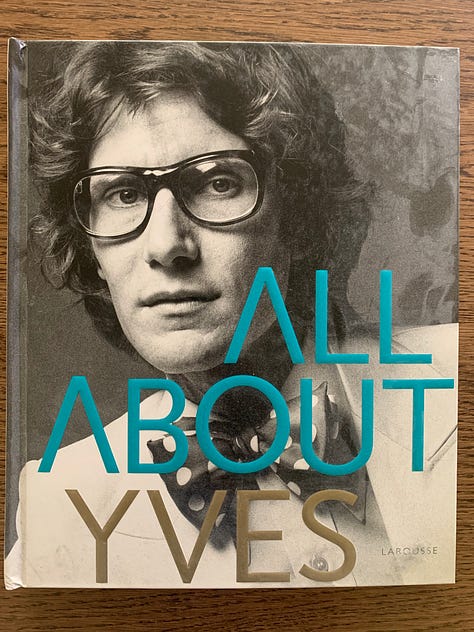
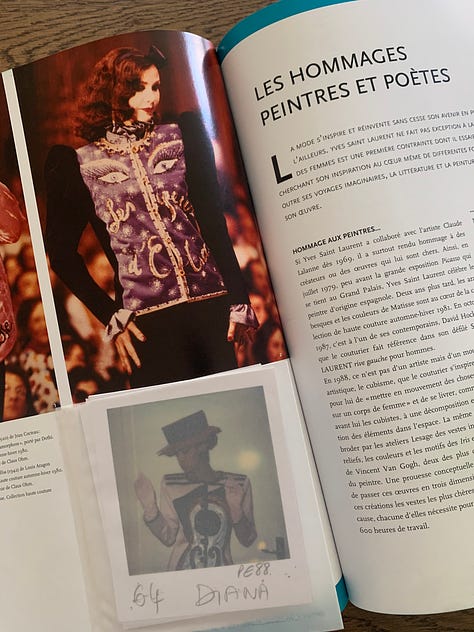
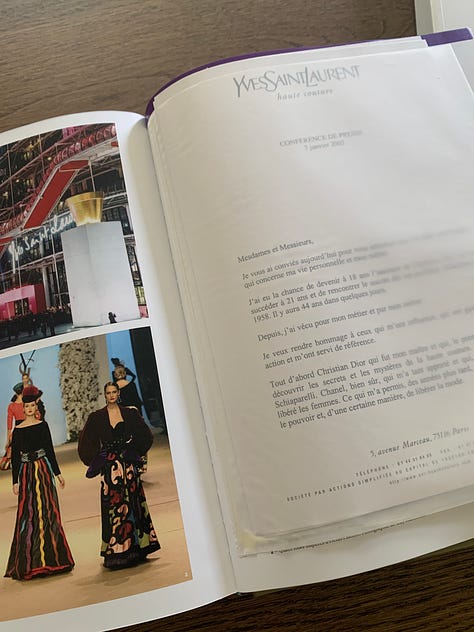
Finally on that trip, I picked up some YSL Parisienne perfume. It’s a little thing I can afford and both wear and look at as a symbol on my dresser. It makes me think of Paris, my muse, not really for its fashions but for its freedom…that you can be who you want and that anybody can create art. And for the ability of artists to create representations of the positive spaces where society is going before, perhaps, more recognized structures of politics and economics can reflect the realities of the people.
I’m writing this article on June 17, in the wake of Jane Birkin’s death and am curious about the paper tomorrow. She seems to me one such enigmatic French figure that could take up such a space. I’m a digital subscriber to Le Monde, but of course this format is much different. Despite the headline ping on my phone, news of her death currently sits at the fourth story down. The paper’s print edition has a Sunday-Monday print, so I’m wondering where they’ll place her tomorrow.


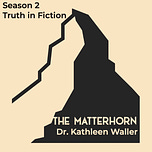


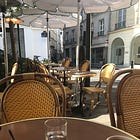









Share this post